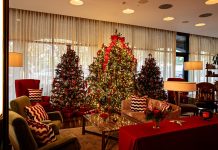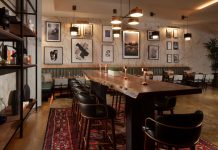It’s a scene out of a storybook: On top of a hill amid the pines, with snow-dusted peaks rising in the distance, sits a palace fit for royalty. Flags whip atop its turrets and towers, and you half expect a sentry to emerge from the ramparts, bugling the arrival of a royal couple to address their subjects gathered below.
 |
| Gstaad Palace in the Swiss Alps. |
Technically, places like that exist only in Disney movies—with one notable exception in the Swiss Alps. The chalet in question, Gstaad Palace, may not be a royal domain, but its history and legend suggest otherwise. It opened in 1913 as a luxury hotel, later catering to families of boarding school students (the winter campus of the fabled Institut Le Rosey is in Gstaad). Despite two world wars and many financial ups and downs, it has remained true to its five-star origins—a distinct advantage in Gstaad, where old-school European glamour reigns supreme.
 |
 |
| Above: The living room of the new Deluxe Suite. Below: Bathtub with a view. |
Visiting in winter is a ritual for moneyed Europeans (and an increasing contingent of Americans), who descend upon Gstaad’s 100-plus miles of slopes for skiing, snowboarding, and other snow sports. One of the coolest (literally) activities on the mountains: crossing the Peak Walk by Tissot at Glacier 3000. This suspension bridge connecting two peaks at 10,000 feet is not for the acrophobic, but it affords a view that cannot be duplicated elsewhere.
 |
| The Peak Walk on Glacier 3000. |
Gstaad Palace is a destination for the winter throngs, not only as the supreme place to stay, but also for après-ski fun. The place to go after dark is GreenGo, the hotel’s nightclub. The club opened in 1971 and still recalls a ’70s disco in both decor and vibe. In winter, the place is absolutely pulsing with the partying jet set, including celebrities like Madonna, David Bowie, and Carey Mulligan, all of whom have been spotted here.
La Fromagerie, located on the hotel’s basement level, is another winter ritual. What is now a popular fondue spot was once a vault where all the Swiss gold was stored during World War II. The armored door is still there to prove it. Descend the steps into this traditional Swiss eatery and swoon over the smell of raclette and Gruyère slowly melting into fondue. Every winter season, La Fromagerie serves four tons of cheese fondue, particularly the truffle-Champagne variety that is the specialty of the house.
 |
| La Fromagerie serves over four tons of fondue every winter. |
Continued on page 2.
Though winter is the main attraction in Gstaad, summer is just as charming. This is the time to break out the hiking shoes and do a bit of exploring in the backcountry. Of the several hikes accessible from Gstaad, the one that should not be missed is the trek to Walig Hut, about two and a half hours’ walk from town.
 |
| Sweeping Alpine views at the Walig Hut. |
Gstaad Palace’s alpine outpost, the Walig Hut is an eighteenth-century farmstead situated amid wildflowers and grazing cows—the perfect Swiss bucolic scene. At the end of the trail, the effort is handsomely rewarded. The fire in the open hearth rages, warming the hand-hewn wood cabin.
 |
| The dining room of the Walig Hut. |
Maurizio Pagliano, the caretaker, greets hikers with a glass of wine and a board of dried meats, all locally produced and as pure as they come. Then, the main event: a beautiful fondue of Swiss cheeses, potatoes, and bread, followed by homemade cookies and petits fours.
 |  |
Left: The Walig Hut’s cobbled forecourt, ideal for morning coffee. Right: Traditional Swiss fondue. | |
Though a morning hike and lunch is the most popular way to experience the hut, overnight options are available. The bed, set with duvets and animal skins, is a notch above glamping, but those with a spirit of adventure—and a yearning to hide—will find bliss here.
For all others, there is the comfort of the Gstaad Palace, with its dramatic views, expertly yet unpretentiously remodeled suites, and authentic Old World charm. It’s truly a modern fairy tale.
 |
| Gstaad Palace overlooks the town, with its charming wooden chalet architecture. |








Facebook Comments